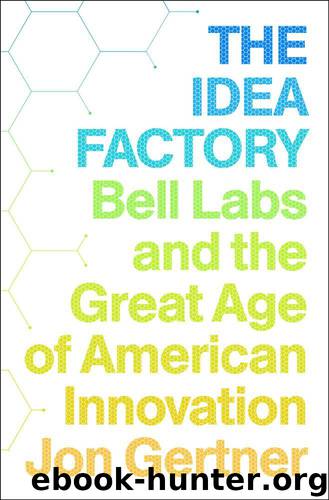The Idea Factory: Bell Labs and the Great Age of American Innovation by Gertner Jon

Author:Gertner, Jon [Gertner, Jon]
Language: eng
Format: mobi, epub
ISBN: 9781101561089
Publisher: Penguin Group
Published: 2012-03-14T16:00:00+00:00
BY 1964, there were about 75 million telephones in the United States, meaning that Bell Labs had now created the means for about 2,500,000,000,000,000 possible interconnections between subscribers.5 In light of this, the Labs’ primary innovation of 1964, for all the attention the Picturephone received, was actually something nobody who used a telephone would see or even understand. It was known as ESS No. 1, a new electronic switching station, opened in a small modern building in the village of Succasunna, New Jersey.6 The design for the switching station had taken two thousand “man-years” of work to create and used tens of thousands of transistors. Its complexity dwarfed that of other previous Bell Labs undertakings such as the transatlantic undersea cable. ESS, as Fred Kappel, the chairman of AT&T, pointed out at its opening in Succasunna, “was the largest single research and development project in Bell System history.”7 The costs were acknowledged by AT&T to be “more than” $100 million, which likely suggested they were much more. Still, its expense was projected to drop dramatically as the ESS technology was deployed all over the country. By the year 2000, Bell executives maintained, all communications switching would be done through electronic means like that in Succasunna, and it would be “better and cheaper”—that golden combination—than the current system.
Why move in this direction? What kind of future did the men envision? One of the more intriguing attributes of the Bell System was that an apparent simplicity—just pick up the phone and dial—hid its increasingly fiendish interior complexity. What also seemed true, and even then looked to be a governing principle of the new information age, was that the more complex the system became in terms of capabilities, speed, and versatility, the simpler and sleeker it appeared. ESS was a case in point. Switching had always been immensely complex, both as a concept and an actual technology. Making untold connections between millions of subscribers, automatically routing a call from one central switching office to another, finding alternate routes (or alternate routes to the alternate routes) if the most direct path for a call was too busy—this was why those who understood the vast interlocking parts of the Bell System called it, as Pierce and Shannon often did, the largest and most complex machine ever built. A visit to a switching office in any city verified this observation. There, one could see the vast banks of crossbar switches—metal matrices, taller than a man, where calls came in and were routed out. To stand before the rectangular crossbars was to hear their constant clicking; to look behind them was to see the ropes of copper wiring, the logic of a programmed machine that encompassed bundles of thousands upon thousands of color-coded copper wires that snaked through and around the machinery so as to connect all to all. The “switching art,” as it was known at Bell Labs, was suitably captured by a specialized technical jargon describing relays, registers, translators, markers, and so forth and a bevy of convoluted, mind-twisting flow charts.
Download
The Idea Factory: Bell Labs and the Great Age of American Innovation by Gertner Jon.epub
This site does not store any files on its server. We only index and link to content provided by other sites. Please contact the content providers to delete copyright contents if any and email us, we'll remove relevant links or contents immediately.
| American National Standards Institute (ANSI) Publications | Architecture |
| History | Measurements |
| Patents & Inventions | Research |
Whiskies Galore by Ian Buxton(41941)
Introduction to Aircraft Design (Cambridge Aerospace Series) by John P. Fielding(33095)
Small Unmanned Fixed-wing Aircraft Design by Andrew J. Keane Andras Sobester James P. Scanlan & András Sóbester & James P. Scanlan(32766)
Craft Beer for the Homebrewer by Michael Agnew(18200)
Turbulence by E. J. Noyes(7983)
The Complete Stick Figure Physics Tutorials by Allen Sarah(7339)
Kaplan MCAT General Chemistry Review by Kaplan(6903)
The Thirst by Nesbo Jo(6882)
Bad Blood by John Carreyrou(6584)
Modelling of Convective Heat and Mass Transfer in Rotating Flows by Igor V. Shevchuk(6408)
Learning SQL by Alan Beaulieu(6239)
Weapons of Math Destruction by Cathy O'Neil(6220)
Man-made Catastrophes and Risk Information Concealment by Dmitry Chernov & Didier Sornette(5958)
Digital Minimalism by Cal Newport;(5707)
Life 3.0: Being Human in the Age of Artificial Intelligence by Tegmark Max(5518)
iGen by Jean M. Twenge(5387)
Secrets of Antigravity Propulsion: Tesla, UFOs, and Classified Aerospace Technology by Ph.D. Paul A. Laviolette(5336)
Design of Trajectory Optimization Approach for Space Maneuver Vehicle Skip Entry Problems by Runqi Chai & Al Savvaris & Antonios Tsourdos & Senchun Chai(5040)
Pale Blue Dot by Carl Sagan(4960)
